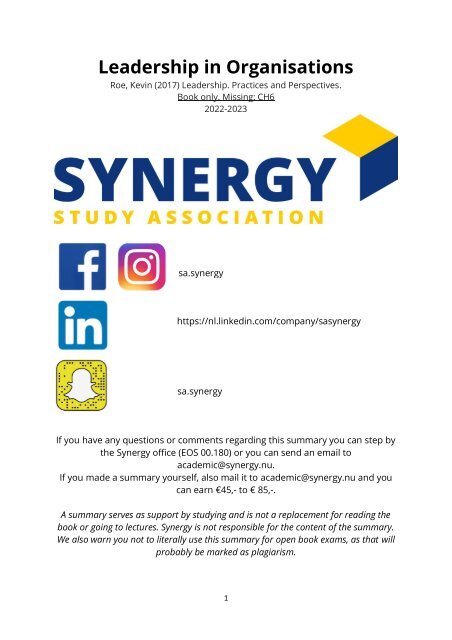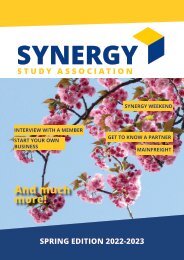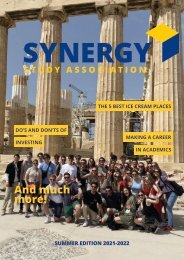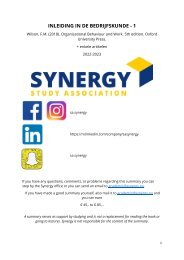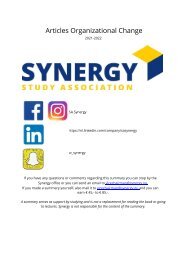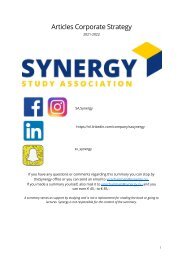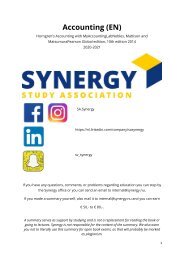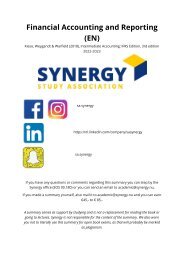Leadership in Organizations
Create successful ePaper yourself
Turn your PDF publications into a flip-book with our unique Google optimized e-Paper software.
<strong>Leadership</strong> <strong>in</strong> Organisations<br />
Roe, Kev<strong>in</strong> (2017) <strong>Leadership</strong>. Practices and Perspectives.<br />
Book only. Miss<strong>in</strong>g: CH6<br />
2022-2023<br />
sa.synergy<br />
https://nl.l<strong>in</strong>ked<strong>in</strong>.com/company/sasynergy<br />
sa.synergy<br />
If you have any questions or comments regard<strong>in</strong>g this summary you can step by<br />
the Synergy office (EOS 00.180) or you can send an email to<br />
academic@synergy.nu.<br />
If you made a summary yourself, also mail it to academic@synergy.nu and you<br />
can earn €45,- to € 85,-.<br />
A summary serves as support by study<strong>in</strong>g and is not a replacement for read<strong>in</strong>g the<br />
book or go<strong>in</strong>g to lectures. Synergy is not responsible for the content of the summary.<br />
We also warn you not to literally use this summary for open book exams, as that will<br />
probably be marked as plagiarism.<br />
1
Table of Contents<br />
Chapter 2 Trait theory – description, analysis, and use ......................................................... 3<br />
Chapter 3 Behavioral models................................................................................................... 5<br />
Chapter 4 The Style approach to leadership .......................................................................... 8<br />
Chapter 5 Situational and cont<strong>in</strong>gent leadership ................................................................ 12<br />
Chapter 13 Power, <strong>in</strong>fluence, and authority ......................................................................... 18<br />
Chapter 15 <strong>Leadership</strong> and change ...................................................................................... 19<br />
Chapter 11 Ethical leadership ................................................................................................ 22<br />
Chapter 12 Diversity & <strong>Leadership</strong> ........................................................................................ 25<br />
*All images and figures <strong>in</strong> this summary are retrieved from Roe, Kev<strong>in</strong> (2017)<br />
<strong>Leadership</strong>. Practices and Perspectives<br />
2
Chapter 2 Trait theory – description, analysis, and use<br />
Trait theory<br />
- Leader is born rather than created or tra<strong>in</strong>ed<br />
- Leader is born with certa<strong>in</strong> character traits (self-confidence or extroversion for<br />
example)<br />
Trait: habitual patterns of behaviour, thought and emotion.<br />
- Accord<strong>in</strong>g to the trait perspective, traits are relatively stable over time, differ<br />
among <strong>in</strong>dividuals, and <strong>in</strong>fluence behaviour.<br />
- There are different views on human characteristics, but this is the most<br />
important one.<br />
Gardner’s list is about traits that good leader should have: physical vitality and stam<strong>in</strong>a,<br />
<strong>in</strong>telligence and action-oriented judgment, eagerness to accept responsibility, task<br />
competence, understand<strong>in</strong>g of followers and their needs, skill <strong>in</strong> deal<strong>in</strong>g with people,<br />
need for achievement, capacity to motivate people, courage and resolution,<br />
trustworth<strong>in</strong>ess, decisiveness, self-confidence, assertiveness, adaptability/flexibility.<br />
Type theory suggests that you can put an <strong>in</strong>dividual <strong>in</strong> 2 variables<br />
(<strong>in</strong>troversion/extraversion) and the <strong>in</strong>dividual is either <strong>in</strong>trovert or extrovert, you cannot<br />
be <strong>in</strong> between the two variables. After do<strong>in</strong>g that with many variables, you can make<br />
assumptions about their likely response to a given stimulus. (Trait approach doesn’t use<br />
this way of classify<strong>in</strong>g people. Trait approach suggest there is a cont<strong>in</strong>uum between the<br />
two variables)<br />
Factor<br />
Openness<br />
Conscientiousness<br />
Extraversion<br />
Agreeableness<br />
Neuroticism<br />
Possible Behavioral Characteristics<br />
Open to new experiences, explore ideas<br />
and concepts<br />
Self-discipl<strong>in</strong>e, act dutifully, aim for<br />
achievement. Display<strong>in</strong>g planned rather<br />
than spontaneous behaviour<br />
Outward, visible signs of energy and<br />
positive emotions. Tendency to seek<br />
stimulation <strong>in</strong> the company of others<br />
Compassionate and cooperative, rather<br />
than suspicious and antagonistic towards<br />
others. Trust<strong>in</strong>g, empathic, sympathetic,<br />
friendly and cooperative nature<br />
Tendency to experience emotions easily,<br />
such as anger, anxiety, depression,<br />
vulnerability. A worrier, emotional and<br />
often upset or down<br />
3
Important to note is that these traits are on a cont<strong>in</strong>uum with ‘high’ and ‘low’.<br />
‘The Great Men’: these ‘Great Men’ were responsible through their own actions for<br />
creat<strong>in</strong>g and shap<strong>in</strong>g the world are considered to be endowed with a genetic makeup<br />
that predisposed them to ‘leadership’. (Natural leaders)<br />
Slowly people came to realize that environment and situation started to play a role. E.g.<br />
Stogdill<br />
Attributes associated with leadership are often viewed as male.<br />
McCall and Lombardo (1983): <strong>in</strong>stead of look<strong>in</strong>g for those traits that earmarked<br />
possessors for a life of leadership, they searched for traits that would prevent or ‘derail’<br />
those with a predisposition or ambition to become ‘leaders’.<br />
- Other words: they looked for the dark side, for personality traits that <strong>in</strong>stead of<br />
enabl<strong>in</strong>g, would disable leadership.<br />
- 5 traits have been found: emotional <strong>in</strong>stability, defensiveness, a lack of <strong>in</strong>tegrity,<br />
over reliance on technical skills, absence of social skills.<br />
Advantage of trait theory: organizations can develop ‘competency frameworks’ to<br />
recruit. (also when transferr<strong>in</strong>g people <strong>in</strong> organizations)<br />
Trait theory can help identify bad managers.<br />
Judge et al. found that the presence of extraversion, conscientiousness, and openness to<br />
new ideas did have a significant positive correlation with leadership effectiveness.<br />
4
Chapter 3 Behavioral models<br />
Summary of behavioural theory: leaders can be made/tra<strong>in</strong>ed with<strong>in</strong> their context<br />
Behavioural approach still focused on person à <strong>in</strong>dividual at the centre of study. Premise<br />
that leadership is about understand<strong>in</strong>g the person rather than the situation or context.<br />
Trait theory: nature VS behavioural theory: nurture<br />
The effective leader can learn these behaviours by appropriate developmental<br />
programmes such as tra<strong>in</strong><strong>in</strong>g courses, role modell<strong>in</strong>g, or executive coach<strong>in</strong>g.<br />
<strong>Organizations</strong> can def<strong>in</strong>e what they consider to be required behaviours.<br />
All behaviours are acquired through condition<strong>in</strong>g.<br />
Condition<strong>in</strong>g:<br />
1. Classical condition<strong>in</strong>g: naturally occurr<strong>in</strong>g stimulus is paired with a response.<br />
Previously neutral stimulus is paired with the naturally occurr<strong>in</strong>g stimulus. Than<br />
the previously neutral stimulus comes to evoke the response without the<br />
presence of the naturally occurr<strong>in</strong>g stimulus. à Pavlov’s experiment with dogs.<br />
2. Operant condition<strong>in</strong>g (=<strong>in</strong>strumental condition<strong>in</strong>g): rewards and punishments for<br />
behaviour. An association is made between behaviour and a consequence for<br />
that behaviour. à Thorndike and Sk<strong>in</strong>ner. (Sk<strong>in</strong>ner formulated a more detailed<br />
analysis: re<strong>in</strong>forcement, punishment, ext<strong>in</strong>ction)<br />
Katz (1955) – 3 skills of a leader<br />
1. Technical skills: technical knowledge of their specialism<br />
2. Human skills: to be able to work with people over the whole organization.<br />
3. Conceptual skills: understand how the organization works together, <strong>in</strong>ternally<br />
and externally.<br />
Activities of a chief executive (Gulick, 1936): POSDCORB<br />
1. Plann<strong>in</strong>g<br />
2. Organiz<strong>in</strong>g: establish<strong>in</strong>g formal structure of authority for subdivisions<br />
3. Staff<strong>in</strong>g: br<strong>in</strong>g<strong>in</strong>g <strong>in</strong> and tra<strong>in</strong><strong>in</strong>g staff, ma<strong>in</strong>ta<strong>in</strong><strong>in</strong>g favourable work conditions<br />
4. Direct<strong>in</strong>g: mak<strong>in</strong>g decisions and embody them <strong>in</strong> specific and general<br />
orders/<strong>in</strong>structions.<br />
5. Coord<strong>in</strong>at<strong>in</strong>g<br />
6. Report<strong>in</strong>g<br />
7. Budget<strong>in</strong>g: plann<strong>in</strong>g, account<strong>in</strong>g and control<br />
5
Taxonomy of managerial roles. 10 ma<strong>in</strong> activities with<strong>in</strong> 3 broad roles: <strong>in</strong>terpersonal,<br />
<strong>in</strong>formation process<strong>in</strong>g and decision mak<strong>in</strong>g role.<br />
Interpersonal roles<br />
• Figurehead: symbolic role. Perform ceremonial duties: sign<strong>in</strong>g documents giv<strong>in</strong>g<br />
speeches at d<strong>in</strong>ners, receiv<strong>in</strong>g formal visitors.<br />
• Leader: def<strong>in</strong>e culture of organization. Provid<strong>in</strong>g guidance and role modell<strong>in</strong>g for<br />
subord<strong>in</strong>ates. Responsible for creat<strong>in</strong>g conditions for work, <strong>in</strong>tegrat<strong>in</strong>g all<br />
functions of the organization and motivat<strong>in</strong>g workforce.<br />
• Liaison: develop and ma<strong>in</strong>ta<strong>in</strong> network of external contacts.<br />
Information-process<strong>in</strong>g roles<br />
• Monitor: understand what is go<strong>in</strong>g on with<strong>in</strong> the organization and its immediate<br />
environment<br />
• Dissem<strong>in</strong>ator: pass<strong>in</strong>g <strong>in</strong>formation down to subord<strong>in</strong>ates<br />
• Spokesperson: transmitt<strong>in</strong>g <strong>in</strong>formation about the organization to external<br />
stakeholders (or <strong>in</strong>ternally when report<strong>in</strong>g to the board)<br />
Decision-mak<strong>in</strong>g role<br />
• Entrepreneur: control and manage change. Take advantage of opportunities<br />
identified via monitor<strong>in</strong>g and network<strong>in</strong>g role.<br />
• Disturbance handler: resolve unforeseen disturbances. Can occupy a significant<br />
proportion of the manger’s workload.<br />
• Resource allocator: schedule <strong>in</strong>dividual employees’ time, programme work and<br />
authorize expenditure.<br />
• Negotiator: negotiate between subord<strong>in</strong>ates and stakeholders when there is a<br />
conflict.<br />
Two fundamental drivers of managerial behaviour<br />
• Task-focused approach: concern for gett<strong>in</strong>g the job done (production based)<br />
• Relationship approach: concern for the people do<strong>in</strong>g the work<br />
Impoverished style: low concern<br />
people, low concern production.<br />
Preserve job and job seniority.<br />
Seek<strong>in</strong>g to protect themselves by<br />
avoid<strong>in</strong>g decisions. Manager<br />
doesn’t want to be held<br />
responsible for any mistakes. Less<br />
<strong>in</strong>novative decisions. Unengaged<br />
with workforce. ‘Keep your head<br />
down <strong>in</strong> case it gets knocked off’.<br />
6<br />
Country club approach: high<br />
concern people, low concern<br />
production. Well-be<strong>in</strong>g, security,
and harmony of employees is important. Friendly and easy-go<strong>in</strong>g sphere, not very<br />
productive.<br />
Authority-comply style: low concern people, high concern production. ‘My way or the<br />
highway’. Employees get direct reward and managers expect compliance and<br />
performance <strong>in</strong> return. Rules and punishments to achieve company goals. (Related to<br />
Theory X). Could be appropriate <strong>in</strong> times of crisis or when a quick decision is required.<br />
Team management: high concern people and high concern production. Encourage<br />
teamwork and commitment among employees. Mak<strong>in</strong>g employees feel they are<br />
constructive parts of the company. Consult with <strong>in</strong>dividuals, share decision mak<strong>in</strong>g,<br />
delegate tasks. Mutual trust and dependency. Individuals are committed and recognize<br />
their part <strong>in</strong> the bus<strong>in</strong>ess process.<br />
Middle of the road: balance and compromise between company goals and workers’<br />
needs. Avoid conflict. Both are half executed <strong>in</strong> this way. Confus<strong>in</strong>g where priorities lie.<br />
Blake and Mouton (1982): Paternalism/Maternalism and Opportunism.<br />
- Paternalism/Maternalism: car<strong>in</strong>g dictator who, as long as you do as you are<br />
<strong>in</strong>structed, will treat you well<br />
- Opportunism: exploit and manipulate. Leader ga<strong>in</strong>s maximum advantage by<br />
us<strong>in</strong>g a different position depend<strong>in</strong>g on their <strong>in</strong>terpretation of what is likely to<br />
result <strong>in</strong> the maximum benefit. Preferr<strong>in</strong>g to adopt the style which offers the<br />
greatest personal benefit.<br />
John Adair (1973) approach to leadership: Achiev<strong>in</strong>g the task, build<strong>in</strong>g and ma<strong>in</strong>ta<strong>in</strong><strong>in</strong>g<br />
the team, develop<strong>in</strong>g the <strong>in</strong>dividual. You need to balance between these three th<strong>in</strong>gs.<br />
Core functions of leadership accord<strong>in</strong>g to John Adair:<br />
- Plann<strong>in</strong>g<br />
- Initiat<strong>in</strong>g<br />
- Controll<strong>in</strong>g<br />
- Support<strong>in</strong>g<br />
- Inform<strong>in</strong>g<br />
- Evaluat<strong>in</strong>g<br />
Individuals can learn leadership capabilities.<br />
Skills may vary across organizations, cultures or different hierarchical layers.<br />
Strengths of this approach<br />
- It gives structure and methodology to develop leaders and leadership <strong>in</strong> their<br />
context<br />
a. if an organization can def<strong>in</strong>e leadership, employees have a template<br />
aga<strong>in</strong>st which they can be mapped or measured<br />
b. this can give direction for development.<br />
Weaknesses of this approach<br />
- <strong>in</strong>clud<strong>in</strong>g the environment makes it complex<br />
7
c. What about <strong>in</strong>dividuals without experience<br />
Mumford three characteristics that need to be <strong>in</strong> <strong>in</strong>dividuals to make the journey<br />
of leadership<br />
1. Will<strong>in</strong>g to tackle difficult and challeng<strong>in</strong>g organizational problems<br />
2. Must be will<strong>in</strong>g to exercise <strong>in</strong>fluence<br />
3. Should be motivated to demonstrate social commitment – do<strong>in</strong>g the right<strong>in</strong>g for<br />
society<br />
L<strong>in</strong>k between skill and effective outcome is not made explicit<br />
➔ Model does not expla<strong>in</strong> how an improvement <strong>in</strong> skill lead to improvement <strong>in</strong><br />
performance<br />
Chapter 4 The Style approach to leadership<br />
The role of, and relationship between, followers and the leader is now considered.<br />
<strong>Leadership</strong> style is the comb<strong>in</strong>ation of traits, skills and behaviours leaders use as they<br />
<strong>in</strong>teract with followers.<br />
In order to be successful, the leader should adopt a leadership style that is appropriate<br />
to the nature of the followers and circumstance the leader <strong>in</strong>habits.<br />
Stogdill’s model of leadership behaviour: consideration and <strong>in</strong>itiat<strong>in</strong>g structures.<br />
- Consideration: the extent to which a leader exhibits concern for the welfare of<br />
the members of the group. Interpersonal relationships, mutual trust, friendship à<br />
relationship oriented<br />
- Initiat<strong>in</strong>g structures: a set of behaviours that <strong>in</strong>volved the leader def<strong>in</strong><strong>in</strong>g leader<br />
and group member roles, <strong>in</strong>itiat<strong>in</strong>g actions, organiz<strong>in</strong>g group activities, and<br />
def<strong>in</strong><strong>in</strong>g how tasks are to be accomplished by the group à task-oriented<br />
University of Michigan had about the same split: employee orientation and production<br />
orientation. But this theory is focused on deliver<strong>in</strong>g results for the organization <strong>in</strong>stead<br />
of develop<strong>in</strong>g strong human relationships.<br />
Michigan model VS Ohio model: Michigan model states employee orientation and<br />
production orientation is on a cont<strong>in</strong>uum. Ohio model states that a leader could<br />
demonstrate both (or no) human and task orientation.<br />
8
Likert – Management System: leadership and the culture of organizations are mutually<br />
dependent. Leaders have a considerable effect on the predom<strong>in</strong>ant culture with<strong>in</strong> the<br />
organizations and the result<strong>in</strong>g relationships between the stakeholders and the<br />
leadership generate different experiences for those stakeholders.<br />
Management system<br />
• Exploitative authoritative system: decisions made exclusively by management.<br />
Follower had to obey <strong>in</strong>structions, no consultation by managers. Coercive use of<br />
power, punishment is consequence for not follow<strong>in</strong>g orders. Task or production<br />
focused.<br />
• Benevolent authoritative system: decisions made exclusively by management.<br />
Strict hierarchies. But: rewards for compliance and effort (not punishment).<br />
Information flows from bottom to top to please the leader. Still task-oriented, but<br />
for the outside it may look like human-oriented.<br />
• Consultative system: limited degree of <strong>in</strong>volvement by subord<strong>in</strong>ates. Leaders are<br />
ask<strong>in</strong>g, listen<strong>in</strong>g and us<strong>in</strong>g some of the subord<strong>in</strong>ates’ ideas. Ultimately, decisions<br />
are made by managers and collected <strong>in</strong>formation may not be used by the leader.<br />
There is a flow up, down and across the bus<strong>in</strong>ess, but the flow is limited <strong>in</strong> terms<br />
of quality and quantity. Rewards as recognition for effort of subord<strong>in</strong>ates.<br />
• Participative (group) system: complete confidence <strong>in</strong> subord<strong>in</strong>ates. Clear and<br />
plentiful flow of communication and subord<strong>in</strong>ates fully <strong>in</strong>volved <strong>in</strong> decision<br />
mak<strong>in</strong>g. ‘L<strong>in</strong>k<strong>in</strong>g p<strong>in</strong>s’: <strong>in</strong>dividuals who belong to more than one team and can<br />
exercise a degree of coord<strong>in</strong>ation across the organization by identify<strong>in</strong>g and<br />
<strong>in</strong>form<strong>in</strong>g teams of the activities of other areas. Comb<strong>in</strong>ed with good<br />
management and achievable goals, this system results <strong>in</strong> more loyalty, better<br />
production, higher motivation and more profit.<br />
Tannenbaum and Schmidt: cont<strong>in</strong>uum of 7 leadership styles<br />
1. Tells: manager makes the decision and announces it. Manager has <strong>in</strong>formation,<br />
makes decision and reports the solution to subord<strong>in</strong>ates. Followers cannot<br />
participate <strong>in</strong> decision mak<strong>in</strong>g. Coercive threat by not follow<strong>in</strong>g order by<br />
subord<strong>in</strong>ates.<br />
2. Sells: manager makes decision, tries to persuade others. Considers the impact on<br />
his followers and that they may react to the decision. Conflict resolution<br />
techniques are needed to <strong>in</strong>fluence the followers when the reaction is not<br />
favourable.<br />
3. Presents solution: manager makes decision, but is prepared to outl<strong>in</strong>e his<br />
th<strong>in</strong>k<strong>in</strong>g by expla<strong>in</strong><strong>in</strong>g the solution to followers. Managers believes decision is<br />
correct, but needs to expla<strong>in</strong> his th<strong>in</strong>k<strong>in</strong>g <strong>in</strong> order to followers understand the<br />
decision. Followers ask questions for clarification, not to challenge the decision.<br />
4. Asks: manager presents decision that could be subject to changes. Subord<strong>in</strong>ates<br />
have limited <strong>in</strong>put. They can give feedback, but the manager can still made his<br />
own decisions, despite the <strong>in</strong>put of the subord<strong>in</strong>ates.<br />
5. Presents problem: manager has identified the problem, but not the solution.<br />
Decision has not been made by the manager, but he made a diagnosis and<br />
identified the challenge. Manager presents the analysis of the problem and<br />
9
subord<strong>in</strong>ates can come up with possible solutions. Manager chooses best<br />
solution.<br />
6. Def<strong>in</strong>es: manager def<strong>in</strong>es the problem, then states the limits and the group can<br />
make the decisions.<br />
7. Participates: group makes decisions. Manager is equal participant, no more<br />
formal authority than other team members. Limits as cash, risk and strategy.<br />
Tannenbaum and<br />
Schmidt say that<br />
there are forces<br />
that <strong>in</strong>fluences<br />
decisions. They explicitly believe that the manger does have a choice! Three areas of<br />
forces: <strong>in</strong> the manager, <strong>in</strong> the subord<strong>in</strong>ates, <strong>in</strong> the situation.<br />
Forces <strong>in</strong> the manager<br />
• Value system: manager knows he can make decisions by himself and has that<br />
authority.<br />
• Confidence <strong>in</strong> subord<strong>in</strong>ates: mak<strong>in</strong>g a judgment call on what he believes the<br />
skill, knowledge and competence his team have <strong>in</strong> order to complete the<br />
assignment. He decides how much he can trust his subord<strong>in</strong>ates to deliver the<br />
tasks. He may decide that his is best qualified to make the decision and not<br />
<strong>in</strong>volve any subord<strong>in</strong>ates.<br />
• Personal leadership tendency: certa<strong>in</strong> ‘traits’ may enable a leader to be more or<br />
less directive <strong>in</strong> decision mak<strong>in</strong>g.<br />
• Manager’s attitude to risk: by releas<strong>in</strong>g the decision-mak<strong>in</strong>g process, he will be<br />
los<strong>in</strong>g control over both process and outcome à higher risk.<br />
Forces <strong>in</strong> the subord<strong>in</strong>ate (nature of the subord<strong>in</strong>ate and the expectations of him)<br />
• Need for <strong>in</strong>dependence: specialist professions need freedom to solve th<strong>in</strong>gs,<br />
because they know it themselves because of their specialism;<br />
• Need for responsibility: the amount of responsibility <strong>in</strong>dividuals are able and<br />
will<strong>in</strong>g to accept.<br />
• Need for boundaries: some people need boundaries to accomplish a task,<br />
others need complete freedom.<br />
• Competence, experience, motivation: these three th<strong>in</strong>gs <strong>in</strong>fluence the<br />
manager’s decision.<br />
10
• Subord<strong>in</strong>ate expectations: expectation management. Subord<strong>in</strong>ates expect<br />
<strong>in</strong>clusion or exclusion with decisions. Also: de degree to which followers have<br />
confidence <strong>in</strong> their boss has to be considered.<br />
Forces <strong>in</strong> the situation<br />
• Organizational type and culture: some organizations will view the role of the<br />
eexecutive very differently from others. Tannenbaum and Schmidt suggest that a<br />
wide dispersal of an organization may preclude participative decision mak<strong>in</strong>g.<br />
But: because of real time video and voice tools, it could be that this concern is no<br />
longer as restrictive as it would have seemed to a manager <strong>in</strong> the ‘50s.<br />
• Team coherence: the extent to which a team is capable and motivated to work<br />
together will be a major <strong>in</strong>fluence on his decision to use group work as a problem<br />
solv<strong>in</strong>g method.<br />
• Task complexity: e.g. for strategic issues the manager th<strong>in</strong>ks he has to do this<br />
himself. But there are also many issues without 'precedent', where many<br />
different people are useful to solve it.<br />
• Time pressure: more time à more delegat<strong>in</strong>g process. Time pressure à less <strong>in</strong>put<br />
for subord<strong>in</strong>ates.<br />
2 factors worth consider<strong>in</strong>g: decision quality (choose the best alternative) and decision<br />
acceptance (of followers).<br />
Strengths and weaknesses of the style approach<br />
• Strengths:<br />
o Richer and dynamic world <strong>in</strong>to consideration<br />
o Research supports this approach<br />
o Not limited by the very essence of a person à it can be learned. Leaders<br />
can develop and could become more effective as a result.<br />
o Takes outside, cont<strong>in</strong>gent and situational forces <strong>in</strong>to account<br />
• Weaknesses:<br />
o It is still not clear how the leader’s style actually <strong>in</strong>fluences the outcomes<br />
of a given task. The leaders style should match the situation.<br />
o No mention of the role of technology<br />
11
o<br />
Oversimplifies the situation, by try<strong>in</strong>g to answer to a complex and<br />
dynamic situation<br />
Chapter 5 Situational and cont<strong>in</strong>gent leadership<br />
To succeed, a leader needs to adapt their behaviour to take knot account the demands<br />
of the situation they face because effective leadership is dependent upon circumstance<br />
and situation.<br />
Anyone can lead as long as they use the correct approach, <strong>in</strong>ferr<strong>in</strong>g that leadership can<br />
be taught and learnt.<br />
For the first time, the view on organizations and management changed à now they th<strong>in</strong>k<br />
organizational form and its associated management and leadership were shaped by<br />
external forces.<br />
<strong>Leadership</strong> style is dependent (cont<strong>in</strong>gent) on situational factors outside the control of<br />
the manager.<br />
Redd<strong>in</strong> (1967) suggested that a different approach is needed <strong>in</strong> different organizations.<br />
He created a three-dimensional model, divided <strong>in</strong> four ‘less effective types’, four ‘latent<br />
types’ and four ‘more effective types’.<br />
Redd<strong>in</strong>’s twelve 3-D styles<br />
No orientation<br />
Relationship<br />
orientation<br />
Task<br />
orientation<br />
Task and<br />
relationship<br />
orientation<br />
Latent Separated Relations Task Integrated<br />
Ineffective Deserter Missionary Autocrat Compromiser<br />
Effective Bureaucrat Developer Benevolent<br />
autocrat<br />
Executive<br />
Four basic (latent) types<br />
1. Separated: ma<strong>in</strong>ta<strong>in</strong><strong>in</strong>g the system and status quo. Largely removed from both<br />
people and tasks.<br />
2. Relations: friendly, open person who is concerned about a pleasant<br />
environment. Communication mostly about personal matters, little focus on<br />
driv<strong>in</strong>g bus<strong>in</strong>ess forward.<br />
3. Task: wants to get the job done. Individual goals more important than the<br />
broader agenda.<br />
4. Integrated: supports teamwork, prefers a shared set of objectives.<br />
Four ‘less effective’ types<br />
5. Deserter (low task/low relationship): might destroy the morale and performance<br />
of his subord<strong>in</strong>ates.<br />
12
6. Missionary (low task/high relationship): more concerned about the people,<br />
production could be disrupted by the need to be seen as popular and friendly<br />
rather than mak<strong>in</strong>g hard decisions.<br />
7. Autocrat (high task/low relationship): task delivered regardless of the human<br />
cost. Uses legitimate authority. Ineffective, because employees only respond<br />
when coercion can be used, are not will<strong>in</strong>gly and may exhibit resistance.<br />
8. Compromiser (high task/high relationship): knows what should be done, but<br />
cannot make the right decisions. Procrast<strong>in</strong>at<strong>in</strong>g and doubt<strong>in</strong>g about decisions,<br />
usually react<strong>in</strong>g to the loudest demand first. Resolve immediate cries, but no<br />
longer term issues.<br />
Four ‘more effective’ types<br />
9. Bureaucrat (low task/low relationship): effective and efficient via a set of rules.<br />
They do not care about the process and people and will little attempt to improve<br />
or modify it.<br />
10. Developer (low task/high relationship): mak<strong>in</strong>g the team deliver<strong>in</strong>g the required<br />
results by coach<strong>in</strong>g them to develop skills, talents and knowledge.<br />
11. Benevolent autocrat (high task/low relationship): deliver<strong>in</strong>g the required goals.<br />
Task achievement is rewarded <strong>in</strong> this culture.<br />
12. Executive (high task/high relationship): recognizes the importance of deliver<strong>in</strong>g<br />
the organization’s requirement, but to achieve this, he looks out for his people.<br />
The manager understands people and how to switch them on, us<strong>in</strong>g motivational<br />
techniques.<br />
Redd<strong>in</strong>’s key observation: the difference between more or less effective managerial<br />
types is a trait-based analysis.<br />
Blanchard <strong>in</strong>troduced The Situational <strong>Leadership</strong> Model. Orig<strong>in</strong>al proposal was that<br />
leader should adjust their approach to their subord<strong>in</strong>ates accord<strong>in</strong>g to conditions<br />
exist<strong>in</strong>g t<strong>in</strong> the wider environment (the situation).<br />
- Psychological read<strong>in</strong>ess: the degree to which an employee is will<strong>in</strong>g to take on<br />
responsibility for their actions <strong>in</strong> relation to task achievement → motivation and<br />
confidence <strong>in</strong> own ability.<br />
- Task read<strong>in</strong>ess: the ability to deliver what is asked. → skills, knowledge, ability of<br />
employee<br />
13
Tell<strong>in</strong>g → Sell<strong>in</strong>g → Participat<strong>in</strong>g → Delegat<strong>in</strong>g<br />
Direct<strong>in</strong>g → Coach<strong>in</strong>g → Support<strong>in</strong>g → Delegat<strong>in</strong>g<br />
The Situational <strong>Leadership</strong> Model<br />
• Two assumptions: there is a task to be achieved and a set of followers available<br />
to deliver the required outcomes.<br />
• First stage: consider the maturity of the follower (state of the follower), judged<br />
aga<strong>in</strong>st the current task requirements.<br />
• 4 different categories followers<br />
o R1: unable to complete the task, because doesn’t possess necessary skills.<br />
Either unwill<strong>in</strong>g to deliver required performance or <strong>in</strong>secure <strong>in</strong> the belief<br />
they can.<br />
o R2: unable to complete the task, but is will<strong>in</strong>g to try. Lack<br />
ability/knowledge/skill but motivated to try.<br />
o R3: necessary technical knowledge acquired, but unwill<strong>in</strong>g to do.<br />
o R4: ready, will<strong>in</strong>g and able to do the required task.<br />
• Second stage: consider their own style or behavioural pattern:<br />
o S1: Tell<strong>in</strong>g (high task/low support). High concern with task delivery, low<br />
concern with development of <strong>in</strong>dividuals. Explanations, clear <strong>in</strong>structions<br />
and supervision.<br />
o S2: Sell<strong>in</strong>g (high task/high support). Leader th<strong>in</strong>ks followers are will<strong>in</strong>g but<br />
not able to complete the task. Leader makes decisions, but also focused<br />
on develop<strong>in</strong>g confidence and skills of followers.<br />
o S3: Support<strong>in</strong>g (low task/high support). Leader encourages and offers<br />
feedback, but confidence <strong>in</strong> followers that they complete the task.<br />
Assumption: follower is capable of achiev<strong>in</strong>g the task, but needs a<br />
supportive environment.<br />
o S3: Delegat<strong>in</strong>g (low task/low support). Autonomy encouraged. Employees<br />
have skills, know-how and motivation to deliver the required, can be left<br />
mostly unsupervised.<br />
• A leader’s preferred style, may not be the most effective style. Use different styles<br />
with the same employee, dependent on the situation.<br />
14
Three basic assumptions of the model<br />
1. As <strong>in</strong>dividuals develop their skills and confidence, they will follow the<br />
development path as described. It is also assumed that <strong>in</strong>dividuals with the same<br />
degree of maturity or read<strong>in</strong>ess will require the same <strong>in</strong>put from the leader.<br />
2. The manager needs the skill and <strong>in</strong>sight to be able to correctly assess the state of<br />
maturity and read<strong>in</strong>ess of his followers.<br />
3. The manager must have the skills and emotional tools to be able to carry off the<br />
four different styles sufficiently well to conv<strong>in</strong>ce his followers theses are genu<strong>in</strong>e<br />
behaviours.<br />
Criticism of The Situational <strong>Leadership</strong> Model<br />
- The model lacks theoretical or logical justification for the way the components of<br />
maturity comb<strong>in</strong>e.<br />
- The flow between the different maturity phases are not always clear why.<br />
- Other factors affect this aspect of a subord<strong>in</strong>ates. Like age, education, culture or<br />
gender.<br />
- Doesn’t help to lead a team with different personalities.<br />
Vroom → Path-Goal theory: suggest a leader should aim to improve followers’<br />
performance by enhanc<strong>in</strong>g their motivation.<br />
- Motivation is an explanation of choices made by organisms among different<br />
voluntary responses (Vroom, 1964). → free choice and trough motivation you<br />
choose the choise you make.<br />
- Valence: the extent to which the <strong>in</strong>dividual considers the outcome of the task<br />
worthwhile. (a manager who wants a promotion will work hard to achieve a task<br />
that is l<strong>in</strong>ked to that promotion)<br />
- Expectancy: the extent a person th<strong>in</strong>ks their efforts will lead to the task be<strong>in</strong>g<br />
achieved.<br />
- Force: a mathematical equation that l<strong>in</strong>ks the two ideas. It suggests the outcome<br />
with the greatest value will be the path followed by the <strong>in</strong>dividual<br />
F = ∑ (E x V) → Force = sum of (expectancy x valence)<br />
House <strong>in</strong>dicated three ma<strong>in</strong> determ<strong>in</strong>ants of how effective a leader would be <strong>in</strong><br />
<strong>in</strong>creas<strong>in</strong>g this motivational force. First, leadership style:<br />
• Participative: consult<strong>in</strong>g with subord<strong>in</strong>ates. Produc<strong>in</strong>g shared decision.<br />
• Directive: tell<strong>in</strong>g <strong>in</strong>dividuals what to do.<br />
• Supportive: group atmosphere, look<strong>in</strong>g after feel<strong>in</strong>gs of the team<br />
• Achievement Orientation: leader sets standards and improves performance by<br />
non-directive methods.<br />
Second, followers characteristics (similar to Hersey and Blanchard)<br />
• Desire for control: external locus of control à directive style. Internal locus of<br />
control → participative style.<br />
• Ability to achieve task: follower’s own view of their ability to achieve the task.<br />
Confident employees less likely to accept a directive style.<br />
15
• Desire for clarity: directive style appropriate for those who need clarity. For<br />
those with a greater tolerance for ambiguity a more ‘hands-off’ approach.<br />
• Need for affiliation: task- or relationship oriented approaches and preferences<br />
of followers.<br />
Third, task characteristics<br />
• Task: rout<strong>in</strong>e or complex? Rout<strong>in</strong>e → leader offers support <strong>in</strong> order to ma<strong>in</strong>ta<strong>in</strong><br />
motivation. Complex → leader need to supply structure and shape to the task.<br />
• Authority System: difference between organizations with formal hierarchy and<br />
organizations with less well-def<strong>in</strong>ed bureaucracy.<br />
• Group norms: difference between groups who look out for each other than<br />
groups with <strong>in</strong>dividuals concerned by their task only.<br />
Criticism:<br />
The complexity of the model may<br />
make it difficult to apply to a ‘real’<br />
situation.<br />
Little empirical data to support the<br />
validity.<br />
Cont<strong>in</strong>gency theory – Fiedler<br />
• The effectiveness of a leader was cont<strong>in</strong>gent upon three dist<strong>in</strong>ct factors or<br />
situational dependent variables.<br />
• He proposed that leader’s effectiveness depends on personality as well as the<br />
degree to which the leadership situation provides control and <strong>in</strong>fluence.<br />
Establish<strong>in</strong>g situational favourableness<br />
1. Leader-member relations: atmosphere with<strong>in</strong> the group, degree of trust and<br />
confidence <strong>in</strong> each other. When leader-member relationships are good, the<br />
leader will have more chance of success <strong>in</strong> terms of <strong>in</strong>fluenc<strong>in</strong>g followers’<br />
op<strong>in</strong>ions and behaviour.<br />
2. Task structure: high structure type task → clear set of stages, well tested process,<br />
unambiguous desired outcome. Little room for creative <strong>in</strong>put, great deal of<br />
control for leader. Four dimensions to be considered with exam<strong>in</strong><strong>in</strong>g high or low<br />
structure of the task: (1) goal clarity, (2) goal-path multiplicity, (3) decision<br />
verification, (4) solution specificity.<br />
3. Leader position power: high level of authority has strong power relationships.<br />
Little authority has weak power relationships.<br />
➔ Favourable situation: leader-member relations are good, task is clear and leader<br />
has legitimate authority.<br />
16
Black box: Fiedler doesn’t answer why a certa<strong>in</strong> style of leader would work <strong>in</strong> one<br />
situation and not another. It is not clear why certa<strong>in</strong> task/team/power comb<strong>in</strong>ations<br />
result <strong>in</strong> certa<strong>in</strong> LPC scores be<strong>in</strong>g favoured over others, and whilst some options feel<br />
<strong>in</strong>tuitively correct.<br />
Criticism: LPC <strong>in</strong>strument is difficult and mislead<strong>in</strong>g.<br />
Kerr and Jermier (1978) had a different view on leadership where the leader was placed<br />
less <strong>in</strong> the centre as <strong>in</strong> the theories before.<br />
<strong>Leadership</strong> Substitute Theory: under certa<strong>in</strong> circumstances, leadership <strong>in</strong> a formal sense<br />
is neither needed nor wanted and may actually have a demotivat<strong>in</strong>g and negative<br />
impact on the achievement of a task.<br />
- Substitutes for leadership: characteristics of the task, organization or followers<br />
that make leadership behaviours either irrelevant or unnecessary.<br />
- Neutralizers for leadership: characteristics that either prevent effective<br />
leadership or nullify the effects of leadership.<br />
Kerr and Jermier described three different aspects of the situation that may mitigate<br />
aga<strong>in</strong>st effective leadership.<br />
1. Characteristics of followers<br />
a. Ability and experience: when employees know what to do and how, you can<br />
better not <strong>in</strong>terfere as a leader.<br />
b. Emotional needs: people who prefer to work unsupervised for example.<br />
c. Professional orientation: only comments from peer group are valued.<br />
d. Reward orientation: degree to which an <strong>in</strong>dividual responds to external<br />
rewards offered by the organization can neutralize any leadership<br />
behaviour.<br />
2. Characteristics of tasks<br />
a. Task structure: simple tasks doesn’t always need leader’s <strong>in</strong>put.<br />
b. Nature of feedback: when feedback is provided by the task outcome,<br />
feedback from the leader is substituted.<br />
c. Intr<strong>in</strong>sic satisfaction: <strong>in</strong>terest<strong>in</strong>g and enjoyable tasks don’t need a leader to<br />
motivate other to complete them.<br />
3. Characteristics of the organization<br />
a. Bureaucracy: when there are many rules that block new ideas, a leader<br />
who wants to <strong>in</strong>vestigate new processes etc. is neutralized.<br />
b. Formalization: when there are clear written contracts, letters of<br />
understand<strong>in</strong>g and codified performance systems, leadership is<br />
neutralized.<br />
c. Group coherence: a group with high degree of coherence may ga<strong>in</strong> all<br />
necessary guidance and support from its own <strong>in</strong>ternal resources without<br />
the need to refer to an outside authority.<br />
d. Limited positional power: predeterm<strong>in</strong>ed bonus structure can limit a<br />
leader’s ability to reward a hard-work<strong>in</strong>g employee.<br />
e. Geographic proximity: the farther away, the harder it is for a leader. Virtual<br />
teams are more difficult to ma<strong>in</strong>ta<strong>in</strong> than static, conventional units.<br />
17
Kerr and Jermier: where substitutes are sufficiently well developed, leadership <strong>in</strong> the<br />
formal sense could be completely discounted.<br />
An <strong>in</strong>experienced, ill-<strong>in</strong>formed leader could neutralize the best laid organizational plans.<br />
Chapter 13 Power, <strong>in</strong>fluence, and authority<br />
Power: the absolute capacity of an <strong>in</strong>dividual agent to <strong>in</strong>fluence the behaviour or<br />
attitudes of one or more designated target persons at a given po<strong>in</strong>t <strong>in</strong> time (Yukl, 2010).<br />
Power: the capacity or potential to <strong>in</strong>fluence (Northouse, 2010).<br />
- Power and <strong>in</strong>fluence are not the same. Power is the force beh<strong>in</strong>d the ability to<br />
<strong>in</strong>fluence.<br />
Three choices of followers when leader has power:<br />
1. Commitment: follower will do their best to ensure the task is completed,<br />
demonstrat<strong>in</strong>g enthusiasm and pride <strong>in</strong> their work.<br />
2. Compliance: follower will do as they have been <strong>in</strong>structed, because they<br />
recognize the legitimacy of the command. M<strong>in</strong>imal amount of effort.<br />
3. Resistance: follower rejects the order.<br />
Types of power (French & Raven, 1959)<br />
• Legitimate power: perceived authority (hierarchy).<br />
o Scope of power associated with the role: if the <strong>in</strong>struction is outside the<br />
scope of de leader’s role, the <strong>in</strong>struction is unlikely to be seen as<br />
legitimate.<br />
o If the person loses or changes role, their legitimate power disappears to.<br />
• Coercive power: punishment or withhold<strong>in</strong>g benefits from the follower. Doesn’t<br />
have to be carried out, the follower must perceive this to be the case. The target<br />
must believe the agent has the capacity and will to carry out the threat.<br />
• Reward power: agent (leader) has the perceived ability to control a resource<br />
valued by the target (follower). Target must believe that agent has the capacity<br />
and will<strong>in</strong>gness to carry through their promise. ‘If you do this for me, I’ll do that<br />
for you’.<br />
• Expert power: knowledge is power. The target must believe the agent to be<br />
credible and trustworthy.<br />
• Referent power: <strong>in</strong>dividuals seek<strong>in</strong>g to please others they feed attracted to, so<br />
that they believe that by do<strong>in</strong>g someth<strong>in</strong>g for them, they will get someth<strong>in</strong>g <strong>in</strong><br />
return (not money, but psychological rewards). Be<strong>in</strong>g <strong>in</strong>fluenced by others you<br />
admire (buy<strong>in</strong>g perfume from a cool person, they th<strong>in</strong>k others are go<strong>in</strong>g to see<br />
them as ‘cool’).<br />
o A leader who does not deliver aga<strong>in</strong>st the promise, will lose referent<br />
power.<br />
18
Clayton (2010) suggested two more ref<strong>in</strong>ements:<br />
1. Connection power: the ability to make connections (network<strong>in</strong>g) is considered a<br />
vital part of the modern manager’s skill set.<br />
2. Resource power: ability to control access to an organizational asset.<br />
Dark side of power:<br />
- Power can be a corrupt<strong>in</strong>g force<br />
- Milgram experiment<br />
Chapter 15 <strong>Leadership</strong> and change<br />
Any successful change process beg<strong>in</strong>s with the understand<strong>in</strong>g of what the new ‘state’<br />
for the organization will look and feel like.<br />
A vision has to be:<br />
• Imag<strong>in</strong>able: creat<strong>in</strong>g a ‘picture’ of what the new future will look like.<br />
• Desirable: needs to be appeal<strong>in</strong>g to all of the stakeholders.<br />
• Feasible: achievable<br />
• Focused: vision should give a clear path for decisions<br />
• Flexible: when circumstances change, leaders and followers may change the<br />
vision<br />
• Communicable<br />
Two models for leaders when consider<strong>in</strong>g what actions need to be taken: HSM and SSM<br />
Hard systems methodology (HSM)<br />
• ‘Tame’ and ‘wicked’ problems. Tame problems are solved with HSM approach → a<br />
problem that can be well def<strong>in</strong>ed and conta<strong>in</strong>ed and has a clear beg<strong>in</strong>n<strong>in</strong>g and<br />
end.<br />
• Measurement and reasoned analysis to come up with a solution to a def<strong>in</strong>ed<br />
problem.<br />
• Concerned with how th<strong>in</strong>gs are done.<br />
• Outl<strong>in</strong><strong>in</strong>g a process:<br />
o 1. Description: recogniz<strong>in</strong>g a problem and be<strong>in</strong>g able to def<strong>in</strong>e the<br />
problem. Objectives and performance measures for example.<br />
o 2. Options: possible solutions can be developed, considered and<br />
prioritized.<br />
o 3. Implementation: preferred option is selected. For implement<strong>in</strong>g, 3<br />
options:<br />
• Test with a pilot<br />
• Old and new systems run <strong>in</strong> parallel.<br />
• Just do it!<br />
19
The 7 S framework<br />
Soft Systems methodology (SSM)<br />
• <strong>Organizations</strong>, societies and human group<strong>in</strong>gs are considered.<br />
• By consider<strong>in</strong>g humans, each person can perceive a situation differently and act<br />
differently.<br />
• When you solve a problem for one person, they may be rise a problem for<br />
another person.<br />
• More concerned with why th<strong>in</strong>gs are done.<br />
• CATWOE:<br />
o Customers: how are these groups or <strong>in</strong>dividuals likely to react when the<br />
changes are announced?<br />
o Actors: who are the groups who will implement any change? Who do I<br />
need to w<strong>in</strong> over?<br />
o Transformation: what changes are be<strong>in</strong>g proposed and how do they<br />
<strong>in</strong>terl<strong>in</strong>k?<br />
o Weltanschauung: worldview. Consider<strong>in</strong>g the big picture<br />
o Owners: who runs the systems? What would make these people follow the<br />
<strong>in</strong>structions? Of what would make them resist the change?<br />
o Environmental constra<strong>in</strong>ts: consider<strong>in</strong>g external factors that may help of<br />
h<strong>in</strong>der.<br />
➔ Make a systems map with the different elements of the problem and show<br />
<strong>in</strong>terconnection<br />
Hard systems methodology<br />
Problem is well def<strong>in</strong>ed<br />
System is clearly bounded<br />
Problem is separable from system<br />
Who ought to be <strong>in</strong>volved is clear<br />
Data to solve the problem is known and<br />
available<br />
Soft systems methodology<br />
Problem can be undef<strong>in</strong>ed<br />
System is fuzzy-edged<br />
What is the problem?<br />
Not sure who ought to be <strong>in</strong>volved<br />
Unsure what <strong>in</strong>formation is needed<br />
20
Know what the solution would look like<br />
Test of success is established<br />
End po<strong>in</strong>t is clear<br />
Not sure what the solution would look<br />
like<br />
Not sure how to measure success<br />
Often no end<br />
Lew<strong>in</strong> (1951): Change process<br />
1. Unfreez<strong>in</strong>g: prepare <strong>in</strong>dividuals and the organization for change. Articulat<strong>in</strong>g new<br />
vision, break<strong>in</strong>g down old structures and processes.<br />
2. Change: new systems, processes and positions can be <strong>in</strong>troduced.<br />
3. Refreez<strong>in</strong>g: move the organization to its new state and embedd<strong>in</strong>g and<br />
confirm<strong>in</strong>g it.<br />
Kotter (1995): eight stages of change<br />
1. Establish a sense of urgency: <strong>in</strong>dividuals need to recognize the need for change.<br />
2. Form a powerful coalition: get a team who have expertise, power and <strong>in</strong>fluence<br />
3. Create a vision: a new future<br />
4. Communicate the vision<br />
5. Empower others: remov<strong>in</strong>g barriers to action<br />
6. Create short term success: create short term milestones and successes. Keeps<br />
<strong>in</strong>dividuals motivated and on track.<br />
7. Consolidate and use success to generate more change<br />
8. Institutionalize the change<br />
Individual reaction to change<br />
• Stage 1: shock and denial<br />
• Stage 2: blame and anger<br />
• Stage 3: exploration<br />
• Stage 4: acceptance<br />
Politics: the use of power through <strong>in</strong>fluenc<strong>in</strong>g techniques and tactics aimed at<br />
accomplish<strong>in</strong>g personal and/or organizational goals.<br />
Types of lies that are <strong>in</strong>tended to advantage the liar (Meltzer, 2003)<br />
• Self-enhancement: over-emphasiz<strong>in</strong>g personal achievement<br />
• Ingratiation: mak<strong>in</strong>g friends with powerful <strong>in</strong>dividuals<br />
• Fraudulent achievement: deliberately falsify<strong>in</strong>g data and records<br />
• The ‘noble’ lie: an attempt to ma<strong>in</strong>ta<strong>in</strong> a false hierarchy by claim<strong>in</strong>g that some<br />
groups are simply not <strong>in</strong>telligent enough the grasp the full implications of a<br />
situation. ‘I can’t tell you, because you wouldn’t understand’<br />
• Permissible exploitive lies: m<strong>in</strong>or distortions designed to hide truths from others.<br />
10 turf games (Buchanan and Badham, 2008) → help managers to establish a position<br />
to <strong>in</strong>fluence the change agenda.<br />
1. Image build<strong>in</strong>g: look<strong>in</strong>g confident. Establish<strong>in</strong>g credibility and appear<strong>in</strong>g<br />
competent.<br />
21
2. Information manipulation: withhold<strong>in</strong>g vital data from others, releas<strong>in</strong>g selective<br />
figures etc.<br />
3. Scapegoat<strong>in</strong>g: blam<strong>in</strong>g someone else for a problem<br />
4. Alliances: to form bonds<br />
5. Network<strong>in</strong>g: turn<strong>in</strong>g up at meet<strong>in</strong>gs or <strong>in</strong>formal events<br />
6. Compromise: one party agrees to support the other <strong>in</strong> return for a favour next<br />
time<br />
7. Bureaucracy: us<strong>in</strong>g organization’s rules, processes and procedures, an <strong>in</strong>dividual<br />
can frustrate opponents by requir<strong>in</strong>g certa<strong>in</strong> documents to be completed etc.<br />
8. Position: choos<strong>in</strong>g projects that enhance your visibility.<br />
9. Sp<strong>in</strong> doctor: alter<strong>in</strong>g messages and <strong>in</strong>formation to suit a particular person or<br />
audience. Tell<strong>in</strong>g people what they want to hear.<br />
10. Dirty tricks: blackmail, gossip and spy<strong>in</strong>g<br />
Chapter 11 Ethical leadership<br />
22<br />
Teleological: goal/end. Looks at the<br />
consequences of an action → the<br />
outcome of a decision has to be<br />
‘good’<br />
Egoism example: manager and his<br />
team w<strong>in</strong> <strong>in</strong> sales competitions and<br />
not share the bonus with other<br />
teams.<br />
- The ‘best’ outcome, is def<strong>in</strong>ed by<br />
the <strong>in</strong>dividual themselves.<br />
Altruism example: Germany let <strong>in</strong><br />
many immigrants from other<br />
countries dur<strong>in</strong>g the 'refugee crisis'.<br />
• Could be destroy<strong>in</strong>g the<br />
<strong>in</strong>dividual himself, and causes that<br />
there is noth<strong>in</strong>g left to give to<br />
others.<br />
Utilitarianism example: <strong>in</strong>vest <strong>in</strong> disease<br />
as diabetes rather than a rare cancer,<br />
because more people will<br />
benefit<strong>in</strong>g. (In practice: impractical)<br />
Deontological framework: the <strong>in</strong>tention of the decision is important, not the<br />
consequence. So an outcome is irrelevant when the <strong>in</strong>tention is good (even if the<br />
outcome is horrible).
Kohlberg (1984): humans are capable of evolv<strong>in</strong>g through a hierarchy of moral justice,<br />
and at each stage they are more effective at resolv<strong>in</strong>g moral dilemmas.<br />
Kohlberg’s level Stage Ma<strong>in</strong> drive Outcome<br />
Level 1: Preconventional<br />
morality<br />
Stage 1<br />
Punishment and<br />
obedience<br />
Do<strong>in</strong>g what is right<br />
based on fear of<br />
punishment<br />
Stage 2 Hedonistic Actions based on<br />
ga<strong>in</strong><strong>in</strong>g personal<br />
reward or ga<strong>in</strong><br />
Level 2:<br />
Conventional<br />
morality<br />
Level 3: postconventional<br />
morality<br />
Stage 3<br />
Stage 4<br />
Stage 5<br />
Interpersonal<br />
relationships<br />
Law and order,<br />
society’s values<br />
Social contract and<br />
democracy<br />
Good is based on<br />
what will please<br />
others<br />
Right th<strong>in</strong>g is driven<br />
by social norms,<br />
rules are fixed<br />
Laws are social<br />
contracts and can<br />
be redef<strong>in</strong>ed and<br />
broken<br />
Stage 6 Inner conscience Self-selection of<br />
universal pr<strong>in</strong>ciples.<br />
Ethical acts are<br />
ends <strong>in</strong> themselves<br />
Level 1 – Pre-conventional morality (is about self <strong>in</strong>terest: avoid<strong>in</strong>g punishment or<br />
ga<strong>in</strong><strong>in</strong>g favour)<br />
• Stage 1: decisions are based on not gett<strong>in</strong>g punished or gett<strong>in</strong>g a favour<br />
• Stage 2: satisfy<strong>in</strong>g their own needs. Self-<strong>in</strong>terest comes first. There might be an<br />
exchange of favours (Swapp<strong>in</strong>g toys or: if you do someth<strong>in</strong>g for me, I owe you)<br />
Level 2 – Conventional morality<br />
• Stage 3: decisions are based on what w<strong>in</strong>s approval from others <strong>in</strong> the social<br />
group<br />
• Stage 4: the right th<strong>in</strong>g is consider<strong>in</strong>g the law and rules <strong>in</strong> society<br />
Level 3 – Post-conventional morality (could be dissonance between what an <strong>in</strong>dividual<br />
wants and what society demands)<br />
• Stage 5: if laws are to be seen as fair, the majority of the population affected by<br />
those laws must agree upon them.<br />
• Stage 6: an <strong>in</strong>dividual understands they can make their own moral framework <strong>in</strong><br />
l<strong>in</strong>e with their own moral conscience. Consider<strong>in</strong>g the needs of others, the<br />
society and their own needs.<br />
23
Criticism: study based on men and ignores female concerns. Women resolve conflict and<br />
dilemmas from a different start<strong>in</strong>g po<strong>in</strong>t, based on care. This criticism led to a new<br />
model:<br />
Garol Gilligan’s Stages of Moral development<br />
Stage<br />
Goal<br />
Pre-conventional<br />
Ma<strong>in</strong> driver is survival. Decisions based<br />
on what is ‘best’ for the <strong>in</strong>dividual<br />
Transition beg<strong>in</strong>s with a move from selfishness to see<strong>in</strong>g a responsibility for others<br />
Conventional<br />
Self-sacrifice is seen as good and moral.<br />
Help<strong>in</strong>g others over the needs of self is<br />
seen as the right th<strong>in</strong>g to do<br />
Transition is when there is an appreciation that as an <strong>in</strong>dividual it is okay to have<br />
wants and needs too<br />
Post-conventional<br />
As well as a broader understand<strong>in</strong>g of<br />
how society works, the <strong>in</strong>dividual is<br />
committed to non-violent solutions and<br />
creative resolution of conflict that meets<br />
the needs of all parties.<br />
There are many reasons for (un)ethical decisions. See book and lectures for more.<br />
Whistleblow<strong>in</strong>g: an <strong>in</strong>dividual raises awareness of poor, bad or illegal practices to a<br />
broader audience<br />
- The <strong>in</strong>dividual may believe there is wrongdo<strong>in</strong>g <strong>in</strong>side an organization and this<br />
can only be righted by exposure to public scrut<strong>in</strong>y. The belief drives them to<br />
speak sensitive, confidential, or embarrass<strong>in</strong>g <strong>in</strong>formation to a wider audience.<br />
24
Chapter 12 Diversity & <strong>Leadership</strong><br />
Diversity can bes een <strong>in</strong> different th<strong>in</strong>gs. Man/woman, diversity whith<strong>in</strong> teams, diversity<br />
with<strong>in</strong> the market etc.<br />
By be<strong>in</strong>g diverse, organizations can avoid some of the negative aspects of hav<strong>in</strong>g a<br />
leadership paradigm that only reflects part of their stakeholders’ values.<br />
There is an idea of some researchers that leaders should be men. In this way it leads to<br />
a self-fulfill<strong>in</strong>g prophecy of men hav<strong>in</strong>g a stranglehold over leadership roles.<br />
Discrim<strong>in</strong>ation: ‘any conduct based on a dist<strong>in</strong>ction made on ground of natural or social<br />
categories, which have no relation either to <strong>in</strong>dividual capacities or merits or to the<br />
concrete behaviour of the <strong>in</strong>dividual person.<br />
NCVO def<strong>in</strong>es diversity <strong>in</strong> the context of organizations as ‘a successfully diverse<br />
workforce is one that conta<strong>in</strong>s people at all levels who have a range of different<br />
characteristics and who have been recruited on the basis of their abilities and<br />
competence to do the job’.<br />
- Presents the leader many challenges: people with different skills, needs, wants.<br />
Identity theory<br />
• Individuals are driven to develop a positive image of themselves and look for<br />
opportunities to build self-esteem.<br />
o For example, associate with other <strong>in</strong>dividuals to re<strong>in</strong>force and build on<br />
this sense of ‘self’, possibly by affiliat<strong>in</strong>g oneself with a group → <strong>in</strong>-group is<br />
the negative consequence when this goes too far. So, identify<strong>in</strong>g with a<br />
group, but when you th<strong>in</strong>k that your group is superior can create and <strong>in</strong>group<br />
and out-group effect.<br />
• By show<strong>in</strong>g favouritism to those perceived as be<strong>in</strong>g <strong>in</strong> your Group, and by<br />
discrim<strong>in</strong>at<strong>in</strong>g aga<strong>in</strong>st those <strong>in</strong> the out-group, an <strong>in</strong>dividual builds self-esteem.<br />
Mummendey (1995) – ‘Positive dist<strong>in</strong>ctiveness’ (us VS them) via a three-stage<br />
process<br />
• Stage 1: categorization. In order to process all the <strong>in</strong>formation that we are<br />
revealed to, our bra<strong>in</strong> categorizes this <strong>in</strong>formation. Male/female; white/black;<br />
Scottisch/Welsch etc. When you put someth<strong>in</strong>g <strong>in</strong> one group, you assume it has<br />
the same characteristics and traits as that group. Criticism: other views that do<br />
not belong to the group can be ignored.<br />
• Stage 2: identification. We def<strong>in</strong>e ourselves <strong>in</strong> the categories and adopt the<br />
behaviour of the groups we wish we can belong to. It gives us a sense of<br />
perspective. We can belong to several groups (student, musician, female etc.)<br />
• Stage 3: comparison. You compare your group with another. Either you make<br />
yourself better, or you talk bad or other groups. Groups beg<strong>in</strong> to compete.<br />
Differences between groups need not actually exist, they are 'perceived<br />
differences'.<br />
25
o<br />
Depersonalization and stereotyp<strong>in</strong>g follow with any number of negative<br />
outcomes, such as violence and war.<br />
Criticism of social identity: theory oversimplifies group behaviour<br />
Benefits of social identity theory<br />
• It can help to understand rivalry between groups<br />
• It can help to identify the pressures to conform to a particular way of behav<strong>in</strong>g.<br />
Women can be a positive contribution to an organization by be<strong>in</strong>g different from<br />
exist<strong>in</strong>g paradigms (<strong>in</strong> the past).<br />
Discussion about women as a leader. Some say that leaders should be men, others say<br />
that women are better suited because their values, traits and abilities to <strong>in</strong>spire others<br />
<strong>in</strong> a more susta<strong>in</strong>able, transformational way.<br />
Labyr<strong>in</strong>th of leadership: two barriers for women which create a structure almost<br />
impossible for women to navigate through:<br />
- Women are communal <strong>in</strong> nature. They are seen as compassionate, concerned for<br />
well-be<strong>in</strong>g of others, gentle and k<strong>in</strong>d. Men are ‘agentic’ (assertive, control,<br />
dom<strong>in</strong>ant). And they say that the traits of an agentic person, are the traits a<br />
leader needs.<br />
- Difficult for women, because if they act like a leader needs to act, they are<br />
oppos<strong>in</strong>g what a woman should do (accord<strong>in</strong>g to the theory).<br />
Eagly & Karau (2002): a group will be judged by society by the degree to which a group<br />
matches society’s expectations from them. (Women will not be viewed as leaders<br />
because their communal attributes do not align with the ‘agentic’ requirements of<br />
leadership.<br />
Veccio (2002): claims of mascul<strong>in</strong>e or fem<strong>in</strong><strong>in</strong>e advantage do not have the data to<br />
support them.<br />
Androgyny = both male and female characteristics.<br />
Bolton and Humphreys (1977): men and women both have agentic and communal traits.<br />
Also: research <strong>in</strong> the area of leadership often has been contam<strong>in</strong>ated by a mascul<strong>in</strong>ity<br />
bias <strong>in</strong> which the task leadership function is viewed as more important than the socialemotional<br />
function.<br />
Effective leaders are not specifically men or women, but an <strong>in</strong>dividual who can exhibit<br />
both mascul<strong>in</strong>e and female behaviours <strong>in</strong> different situations.<br />
Diversity and culture<br />
• Different parts of the world view leadership different.<br />
26
• GLOBE project: aim of determ<strong>in</strong><strong>in</strong>g the extent to which the practices and values<br />
of bus<strong>in</strong>ess leadership are universal (i.e. are similar globally) and the extent to<br />
which they are specific to just a few societies.<br />
Hofdstede<br />
Power distance<br />
GLOBE<br />
Power distance<br />
Uncerta<strong>in</strong>ty avoidance<br />
Collectivism Collectivism (1)<br />
Collectivism (2)<br />
Long term orientation<br />
Humane orientation<br />
Assertiveness<br />
Uncerta<strong>in</strong>ty avoidance<br />
Gender egalitarianism<br />
Long term orientation<br />
Mascul<strong>in</strong>ity<br />
Performance orientation<br />
After the GLOBE project, the next stage was to develop 6 global leadership behaviours:<br />
1. Charismatic/value-based: <strong>in</strong>spire, motivate followers<br />
2. Team oriented: emphasizes team-build<strong>in</strong>g and a common purpose or goal<br />
3. Participative: <strong>in</strong>volve others <strong>in</strong> decision-mak<strong>in</strong>g<br />
4. Humane oriented: supportive and considerate leadership. Compassion and<br />
generosity.<br />
5. Self-protective: the degree to which the leader seeks to preserve the <strong>in</strong>tegrity<br />
and power of the group. Be<strong>in</strong>g status- and class-conscious, evasive, ritualistic,<br />
procedural, normative, secretive, <strong>in</strong>direct, self-centred, asocial (you should not be<br />
this)<br />
6. Autonomous: leader operates <strong>in</strong>dependently and is seen by others as unique<br />
and autonomous<br />
27


